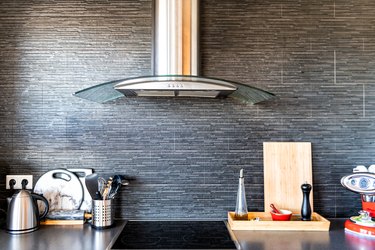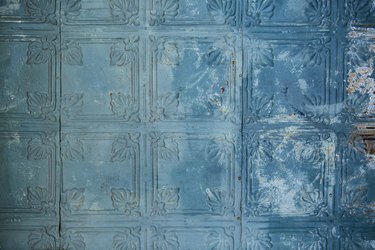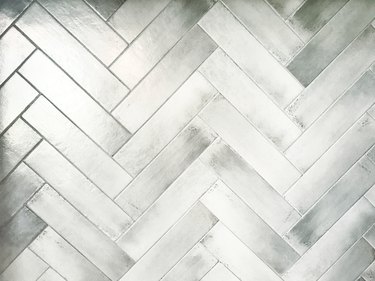
In This Article
Tin tiles are a kitchen-backsplash option that confer an old-world look on your kitchen that goes well with many décor themes. For example, you can add tin to a kitchen dominated by wood features, and you'll be back in Victorian times, when tin tiles had their heyday. You can also add textural interest and color by incorporating tin tiles into a minimalist design dominated by monochromatic walls and stone countertops.
Tin is a highly malleable metal that can be stamped with any number of decorative patterns, and the tiles, which are typically 4 inches square, usually come imprinted on 2 x 2-foot or 2 x 4-foot tin panels. Finishes range from clear to burnished copper, metallic brass and paints with all the variety of colors of the rainbow, so you have plenty of choices. A tin backsplash is one of the easiest for the DIY remodeler to install, so there isn't much to not like, but like all home-improvement materials, tin tiles do have their drawbacks.
Video of the Day
Video of the Day
What Are Tin Tiles?
Before examining the pros and cons of tin tiles, it's important to know what they are. When you're looking for them online, you'll find plenty of tin ceiling tiles that you can easily adapt for use as a backsplash. If you're looking for tin tiles manufactured exclusively for backsplash use, however, you might have to do some extra searching. Armstrong is one of just a few high-profile companies that offers a selection of tin backsplash tiles.
Tin tiles are thin and light, and you can easily cut them with tin snips or a heavy-duty paper cutter. Their lightweight nature is both a plus and a minus. Because they don't weigh much, they are highly workable, and adhesive holds them easily, but they also require care when you're handling them because they bend easily. Also, don't forget the sharp edges!
The appeal of tin tiles, besides the metallic element they contribute to your kitchen, is the virtually unlimited number of ornate patterns that can be stamped on the surface, as evidenced by American Tin. They can be floral, geometric or a combination of different styles. Because a wide range of finishes is also available, tin can fit in almost any kitchen or bathroom.

Reasons to Choose Tin
Design considerations aside, the purpose of a backsplash is to protect the wall from splashing liquids such as hot water from the sink and oil and grease from the stove. Besides tin, some of the most common backsplash materials include
- Ceramic tiles
- Laminates
- Solid stone
- Wood
- Metal tile other than tin, such as stainless steel
None of these are as easy to install as tin tiles, some of which come with self-adhesive backing, eliminating the need to even apply glue. Besides ease of installation, tin tiles offer other benefits as well.
- Tin is nonflammable: You most need a backsplash on the wall behind the stove, where you can't install flammable materials like wood or laminate. As Ask the Builder notes, a tin tile backsplash tells the world that you aren't afraid to take design chances, and it also says that you're serious about safety.
- Tin tiles aren't expensive: Tin tiles can cost as little as $3 per square foot, and an entire backsplash consisting of eight 2 x 2-foot panels can be had for under $100. Compare this with a ceramic-tile backsplash, which can cost upward of $30 per square foot — not including installation. Add the fact that tin is a DIY-friendly material and you can install the tiles yourself, and the savings over a material like tile or stone can be considerable.
- Tin is easy to clean: Unlike wood and ceramic-tile grout, tin is nonporous and provides no small crevices for dirt and mold to accumulate (except along the seams). Tin tiles are made with a hard finish that's easy to keep clean using soap and water.
- Tin tiles are eco-friendly: Manufacturers often fabricate tin tiles from recycled metal, making it possible for the tuna can you threw away a few years ago to adorn your walls tomorrow. If you should decide to replace your tin backsplash, it won't sit in the landfill slowly decomposing because it can easily be recycled to make new backsplashes (or more tuna cans).
Some Drawbacks of Tin Tiles
No backsplash material is perfect, and a tin backsplash, while cheap, eco-friendly and stylish, does have drawbacks that might force you to keep searching for other backsplash materials. The fact that tin is lightweight, for example, won't be much good if your kitchen is drafty and needs extra thermal insulation. Some other problems you might encounter with a tin backsplash include:
- Tin is busy: Tin tiles with ornate designs and bright colors create a lot of visual stimulation, and in a kitchen with wood floors, tile countertops and other features that draw attention, that might be the last thing you need. Just as you would complement a multicolored tile countertop with a mosaic tile backsplash only at your own peril, installing a tin backsplash in a kitchen that already has strong design elements may give you a case of buyer's remorse.
- Tin corrodes: If you leave tin exposed to the elements, it will rust. This shouldn't be a problem because tin backsplashes come with a corrosion-resistant finish, but common household acids such as vinegar, lemon juice and coffee can etch this finish and damage the tin underneath. Rust is removable, but if the tin corrodes, it can be difficult to repair seamlessly, and if your backsplash gets damaged by corrosion, you might have to replace it.
- Tin dents: If you should happen to bump your tin backsplash with a heavy item such as a frying pan, the lightweight, fragile metal backsplash could sustain a dent that you'll find difficult to remove. Dents are particularly likely on highly featured tiles with crowning points that extend a good distance from the wall, and these are exactly the tiles on which dents will be most noticeable.

What's Involved With Installation?
Every bathroom or kitchen backsplash installation calls for a certain amount of wall preparation, and a tin backsplash doesn't require any more preparation than any other type. The wall must be flat, of course, so if there are any undulations, you need to level them with joint compound. You should also clean the wall and degloss the finish to make sure the tiles stick.
A certain amount of cutting is involved to get the panels to fit inside the backsplash area and to create holes and notches for electrical outlets. You can cut tin with tin snips, or you can use a paper cutter, but either way, the process leaves a sharp edge that you have to cover to prevent injuries. Backsplash panels often come with proprietary metal molding that goes around the perimeter of the backsplash to cover the edges, or you can use the same type of wood trim you use for beadboard or other types of paneling.
Because tin is thin, you usually don't need to remove outlets from the electrical boxes, although you should turn off power to them while you're doing the installation. All that's needed is to remove the cover plates, measure the box locations, cut the holes, fit the backsplash around the boxes and replace the cover plates when the installation is complete.
Note: If the tin tiles have a deep texture and add more than about 1/4 inch to the wall thickness, install electrical box extenders to bring the front edges of the electrical boxes up to the faces of the tin tiles. This is an important safety precaution that is required by most building codes.
What Do You Use to Affix the Panels?
It's possible to adhere tin tiles to the wall using brad nails, but the nails won't hold unless you drive them into wall studs, which means the stud spacing must correspond to the panel dimensions. This is seldom the case, so most installers use construction adhesive such as Liquid Nails to hold the panels. If you're using self-adhering panels, then no extra adhesive is required — just peel the backing and press the panel against the wall.
Construction adhesive comes in tubes, and you apply it to the backs of the panels with a caulking gun. Apply a bead around the perimeter of the panel and around the perimeters of any cutouts you make for outlets and switches and then apply beads to the rest of the panel in an S-shaped configuration, spacing the beads about 6 inches apart. Push the panel against the wall, and because it doesn't weigh much, the glue should hold it in place.
How to Keep Tin Tiles Clean
One of the advantages of tin tiles is that they require little maintenance, but they do need some. If you get oil or grease splashes on the backsplash, you can clean them off with a dish detergent solution and a sponge. Avoid using acidic cleaners such as vinegar or lemon juice and caustic ones such as ammonia and bleach because these chemicals can damage the finish on the tiles.
Some metal tile finishes are more sensitive than others, especially to solvents such as acetone and alcohol, so when in doubt, consult the manufacturer's recommendations for the best cleaner for your particular product.
It's important to clean up oil and grease spills as soon as they occur because if the grease should harden, you can't simply scrape it off with a metal implement or rub it off with steel wool without scratching the metal. If you need to scrub off hardened grease, cover it with white toothpaste or a paste made from baking soda and water, allow the paste to sit for a few minutes and then scrub it with a nylon scrubby or a toothbrush or scrape it with a plastic putty knife.
Removing Rust and Keeping Your Backsplash Shiny
As your tin backsplash ages, a certain amount of rust is inevitable given that humidity tends to be higher in the kitchen than elsewhere and that no protective finish lasts forever. You should remove this rust as soon as you notice it so it doesn't have a chance to degrade the metal. Use a commercial rust remover for this, following the directions on the container.
To keep the tiles shiny, a weekly wipe-down with a solution of dish detergent and water is recommended, followed by the application of a polish such as Mr. Sheen, which deposits a thin layer of wax on the surface that you can buff up with a soft cloth. You can also apply liquid car wax but do so sparingly and only occasionally because a buildup of wax can collect dirt and dull the finish, which is the exact opposite of what you want.
- American Tin: All Tin Tile Colors & Patterns
- Ask the Builder: Metal Backsplash
- YouTube: American Tin Ceilings: Installing a Kitchen Backsplash
- YouTube: Decorative Ceiling Tiles, Inc: How to install Tin Tile Backsplash in Your Kitchen
- American Tin Ceilings: How Much Did It Cost to Buy & Install Your Backsplash?
- Armstrong: Tin Backsplash Tiles